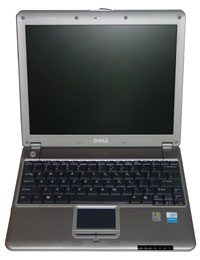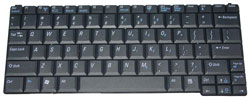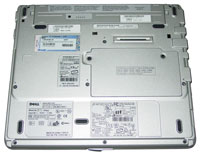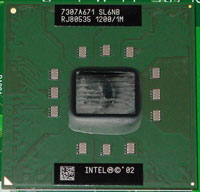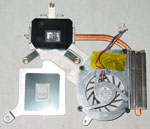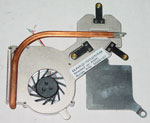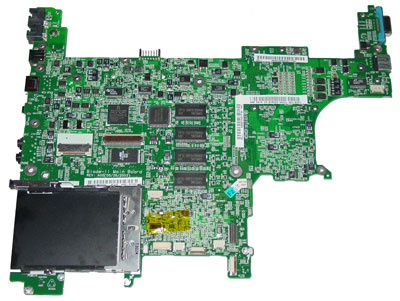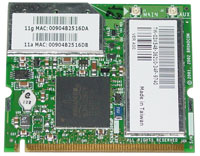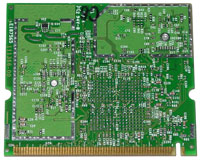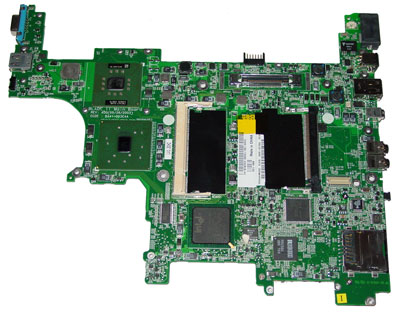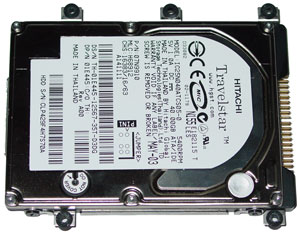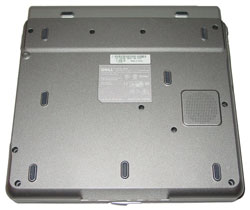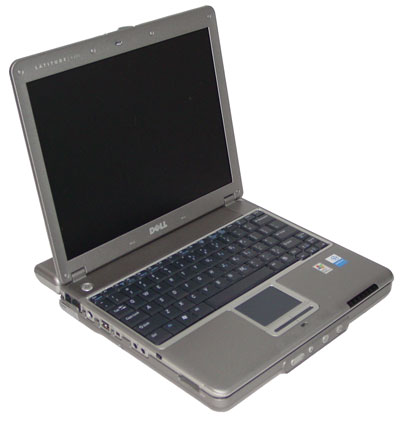
Original Link: https://www.anandtech.com/show/1188
Dell Latitude X300: A Traveler's Companion
by Andrew Ku on October 30, 2003 5:53 PM EST- Posted in
- Laptops
Ultraportable notebooks have become more popular, a direct result of the Pentium-M mobile processor and Centrino technology. As we mentioned before, system designers had two options available when producing a notebook with a manageable size. For one, they could use the low voltage Pentium III-M chip, which provided to be good speed, but wasn't very forgiving on the power side of things. The other option was to choose Transmeta's Crusoe processor, which proved to use very little power, but at the sacrifice of speed. The Pentium-M mobile processor combines the best of both of these processors, resulting in a power conscious chip that has plenty of performance.
As a result, the Pentium-M fits perfectly into the thin, light and ultraportable designation. Mobile systems of this nature don't have a large amount of space with which to work, nor a large battery. Considering this and the performance needed, processors in these systems need to match a unique set of characteristics.
In our Centrino based notebook roundup, we looked at four notebooks, mostly thin and light notebooks (though, one vaguely could fall between the thin and light and the desktop replacement classification). Since that time, we have only been able to check out one true ultraportable notebook: IBM ThinkPad X31. We also looked at the Acer TravelMate C110, which could be considered an ultraportable notebook only because it is a convertible tablet PC with the footprint of a typical slate tablet PC.
It really hasn't been too much of a surprise to see ultraportable notebooks sold better overseas. As it stands in the North American market, we typically want the fastest computer now and, many times, are willing to sacrifice battery life to get it. This is why desktop replacements systems fare better here than overseas. While this is due to a mix of cultural and demographic reasons, the popularity of ultraportable notebooks is on the rise domestically. Many of the same obstacles that tablet PCs are facing also apply to ultraportable notebooks, as the price tag still is too high for many to consider in addition to a primary system.
The most popular of the ultraportable systems come from the big three: IBM, HP/Compaq, and Dell. We have already seen ultraportable systems from all three system vendors, but have yet to put all of them through the paces. Today, we look at a notebook style that we hope will continue to populate the market, a sub 4-pound ultraportable notebook with all the trimmings that we come to expect from an on-the-go solution: high performance, ultraportable, and a much needed boost in battery life. Dell calls theirs the X300, and it comes from the Latitude product line meant for business users.
Construction — Build, Appearance, Size
The X300 continues the Latitude tradition with its Ion Silver color scheme. The notebook is easy to open via a single sliding clip.Click to enlarge.
Opening up the Latitude X300 reveals a 12.1" XGA (1024x768) screen, which is the standard for ultraportable notebooks. Anything larger wouldn't keep the small footprint needed to design a notebook of this style. As we have noted before, slightly larger screens supporting only XGA resolutions at many times look odd, but 1024x768 fits the 12.1" screen perfectly.
One of the tendencies of moving to an ultraportable design is the necessary sacrifices needed to be made to maximize the use of space. Often, the keyboard layout is the first thing to be altered, and this results in keyboard keys that are a bit too small for conformability. Similar to the IBM ThinkPad X31, the X300 uses a full size keyboard similar to higher end Dell notebooks, specifically the Inspiron 8600. The alphanumeric keys are full-sized and very comparable to the Inspiron 8600, and so, to cut down on the space used, the real estate of function keys (control, shift, etc.) have been slightly reduced. We still prefer the quality of the keyboard on the X31 compared to the X300, as IBM's ultraportable has a better tactile feel.
On the subject of layout, Dell includes a windows key, which IBM doesn't. The X300 also makes a good note of placing the control key on the far left, which is definitely a plus.
Click to enlarge.
Oddly enough, we were a bit surprised that the set of buttons for the touchpad has a strip of rubber. Dell told us this was for aesthetic detail and to add tactile response (basically, some grip). This did take some time to get used to, but we did like this little add-on, and some texture in the rubber strip is something we would like to see in the future. Perhaps, Dell can create different rubber strips, like there is for the IBM track stick, which is missing from this notebook. This is a love-it or hate-it feature, but something we are personally fans of. Sound is supplied via two small speakers, which are directly below the touchpad buttons. This placement keeps them a bit away from typing hands, but placed so they can still direct sound toward the user.

There are no function buttons on the X300, as the power button is the only button apparent. It is interesting to note that once the battery is removed, there is a significant gap between the keyboard and the screen. The screen hinges on two parts of the frame that extend toward it. There is no hinge in between.

There is only one set of LEDs on the X300, which are present on the lower right hand edge of the frame. The front of the X300 slopes down slightly, which allows the LEDs to be partially visible while closed. There are seven LEDs at this location (left to right): number lock status, caps lock status, scroll lock status, power state, hard drive activity, battery state, and Bluetooth receiver status. We didn't have Bluetooth in our sample, so we aren't able to say what color LED it uses, though we suspect it is green. All of the LEDs use green to indicate status, but the battery LED will turn orange when low.

Construction — Build, Appearance, Size (continued)
The X300 is intentionally designed with a small size in mind, so we weren't too surprised at the front of the system. Sound can still be heard well enough from the system speakers, though a bit muffled since the front of the system is angled down a bit. The LEDs can also be seen slightly, but for the most part, only when looking dead on or at an angle.Click to enlarge.
The left side of the X300 reveals more functionality. First up are the system's secure digital and a PCMCIA slot. Personally, we prefer the hanging door to the dummy PCMCIA card. It was a bit unexpected for us to see a secure digital slot on the X300, though Dell's handhelds implement it.
Next up are the audio jacks: headphone out and microphone in. The absence of line out is due to the redundancy that headphone out and line out bring together. We are glad to see the X300 come with firewire support; in this case, a 4-pin IEEE-1394 firewire port. As we have mentioned before, we would have forgiven the absence of one as a result of the system's small size.
Left of the firewire port is a USB 2.0 port and above it a “D/Bay” connector. While the “D/Bay” connector looks similar to a USB 2.0 connector, it is actually used to power external modular devices produced by Dell, such as an external DVD-ROM drive. The power rail is necessary to prevent power hungry external devices (like that DVD drive) from requiring a wall plug while operating. Also on the right side are the power in port, ethernet jack, and modem jack. As mentioned previously, Dell has finally strayed away from keyed power plugs on previous notebooks (Latitude and Inspiron) lines in favor of a circular plug which can be inserted in any direction.
Click to enlarge.
The back of the system is actually barer than the front, which is something we don't often see. The only things on the back are the battery and a lock port to the far right.
Click to enlarge.
On the right side, the X300 is home to the VGA-out port, which is usually on the back. This placement does limit the orientation of the system in relation to the external monitor. An additional USB 2.0 port is also on the right side, as well as an IR window and the system's exhaust vent. There is no actual intake vent, as air is drawn in through the various system crevices specifically the ports.
Click to enlarge.
The bottom of the X300 reveals the system's 14.8V 1.9AH Lithium Ion battery along with an access panel. The access panel in the middle of the system is home to the unit's single SODIMM slot, mini-PCI slot, and the modem. Behind the access panel is the docking station port, which is covered while not in use by two springed doors. The metal housing the docking port and at the back of the system are used as additional electrical connectors for the docking station, likely acting as grounds.
| Click to enlarge. |
Click to enlarge. |
The Dell Latitude X300 fits nicely in the ultraportable class, measuring in at 10.8" x 9.2" and 0.9" thick. Our X300 weighs in at 2.9 pounds, much lighter than the Inspiron 8600 and noticeably less than the IBM ThinkPad X31.
Construction — Under the Hood
The performance of the X300 comes from the use of Intel's Centrino technology. Our system came configured with a 1.2GHz Pentium-M processor, the Intel 855GM chipset, 256MB DDR PC2100 memory, WiFi connectivity, and a 40.0GB 5400RPM hard drive.The low voltage 1.2GHz Pentium-M that the X300 uses is a slower version of the Pentium-M family, as it has a smaller thermal footprint. Like the other ultraportable systems we have looked at, the CPU for the X300 is mounted directly on the system's motherboard. This is most likely in order to save space and quite frankly, doesn't bother us. Even if it were socketed, it would be hard to upgrade the CPU, because it is hard to get access and acquiring a single socketed Pentium-M would be extremely difficult. Note that the CPU makes contact with the heatsink with some thermal grease.
Click to enlarge.
The CPU and northbridge is cooled via an aluminum heatsink and fan. The heatsink surface connects to the CPU via a copper heat pipe. The fan that the unit employs is temperature controlled, and remained quiet throughout the duration of the testing on the whole.
| Click to enlarge. |
Click to enlarge. |
Mounted directly below the CPU is the system's 855GM northbridge. From our talks with IBM regarding the IBM X31, we learned that the 855GM (integrated graphics) has poorer content creation performance compared to discrete graphic processors, such as the Mobility Radeon. It seems that Dell has chosen to maximize the use of space over this type of performance margin.

The system's ethernet controller is located on the top side of the motherboard. Our X300 came outfitted with the Broadcom BCM5705MKFB Gigabit ethernet controller. While the X300 doesn't support Gigabit ethernet, the addition of MediaBase supports Gigabit via the same chip. Dell told us that they used this chip so that the driver and the use of the MediaBase would be seamless. Additionally, Dell explains that the reason behind the lack of ethernet support on the system is due to space (specifically height) issues, which only allow the placement for a smaller transformer (one pair of the two pairs of pins on the transformer needed for Gigabit support).

The AC'97 audio codec is also on the bottom of the motherboard. For this, Dell turned to the SigmaTel C-Major STAC9750T.

As seen below, the motherboard of the X300 is fairly small and packed.
Click to enlarge.
Construction — Under the Hood (continued)
As we mentioned before, our X300 came configured with 256MB. There is 128MB of DDR PC2100 mounted directly on the motherboard, which is why our single SODIMM slot came populated with a Samsung 128MB DDR PC2100 memory module. The highest amount of memory that the X300 can support is therefore 1152MB.| Click to enlarge. |
Click to enlarge. |

The mini-PCI slot on our X300 came configured with the Dell TrueMobile 1400 dual band wireless card. Because of this, our system doesn't qualify as a Centrino system (because Intel didn't make the card). Though to be fair, the X300 is default configured with the Intel Pro/Wireless 2100 card. We like many of the non-Intel WiFi cards on the market as they often times support more than just the 802.11b infrastructure. In the case of the Dell TrueMobile 1400 dual band wireless card, we get 802.11a (54Mbps) and 802.11g (54Mbps), in addition to 802.11b. We have yet to toy around with 802.11g stuff, but once we do, we will report back.
|
Click to enlarge. |
Click to enlarge. |
To the right of the mini-PCI slot, the Conexant D480 modem interfaces with the motherboard.
| Click to enlarge. |
Click to enlarge. |
The bottom of the motherboard is shown below and most of the chips populate this side, including the Ricoh R5C591, which serves as the IEEE 1394 firewire and PC Card controller.
Click to enlarge.
The hard drive that came in our Latitude X300 is the Hitachi Travelstar 40GNX 40.0GB 5400RPM. We were surprised that Dell chose to use a 5400RPM, considering that we saw a 4200RPM on the IBM X31. The power consumption for a 5400RPM is still slightly greater than a 4200RPM drive and will affect battery life accordingly. For an ultraportable notebook, we would prefer to see a 4200RPM drive implemented, as that would squeeze out the maximum amount of battery life possible.
Click to enlarge.
We mentioned that the X300 has two small speakers, one of which is pictured below. This is perhaps one of the smallest speakers that we have seen to date.

Features — Hardware
Dell also sent along the X300's MediaBase docking station. A docking station in the case of an ultraportable system provides more than just port replication for the system. The MediaBase brings additional ports including a serial port and a PS/2 mouse port that the X300 doesn't provide, clearly due to space issues. The use of MediaBase also adds Gigabit ethernet support.Our system also came with a second battery, which provides more battery life than the primary X300 battery. As shown below, X300's 14.8V 4.4AH extended life battery is much wider than the primary battery. Its use limits the 180 degree range of the screen. It also makes it harder to see and use the ports on the back. Additionally, it does make the system look a bit odd, and our own preference is the primary battery. The extended life battery works better as a solution away from the docking station.
The right side reveals the MediaBase modular bay. Our system came with a DVD-ROM, which can be switched easily enough to a CD-ROM, DVD-ROM, CD-RW/DVD-ROM combo drive, or a DVD+RW drive. This would depend on the additional modular bay purchase made. The VGA-port is blocked because it is replicated on the back of the docking station.
The front of MediaBase reveals a few buttons (left to right): undock, power on, mute, and volume up and down. All are green LEDs.
The left side of the system is the release clip to the docking station and the docking station's subwoofer. Because the MediaBase has an ethernet port replicator, the ethernet jack on the laptop is blocked off.
The primary battery is housed on the top side of the MediaBase, and obviously, the extended life battery will not be able to fit in the docking station. The battery cover has a small window, so that the battery status can still be viewed. We will reserve judgment on the usefulness of the extra battery till we look at the test results.
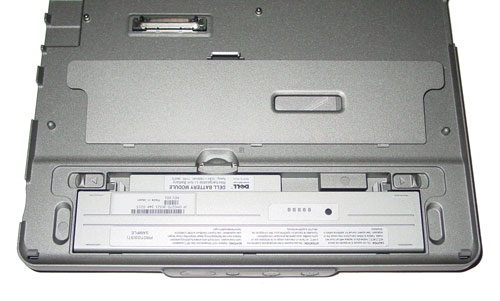
The bottom of the MediaBase shows the subwoofer. Other than that, there is nothing else revealed on the bottom of the docking station.
The docking process is easy enough: just slide the front of the X300 into the MediaBase and press down. Undocking is the same. Hit the undocking button on the front of the docking station, and pull the release level on the left side.
While the MediaBase offers more functionality than the X300 alone, it does come with a price: an increase size and weight. The MediaBase itself is 10.8" x 9.3" x 0.79" and weighs 1.9 pounds. Therefore when docked, the MediaBase increases the total system height to just shy of 2 inches (1.88 inches to be exact), while the weight of the system increases to 5.3 pounds.
We found the addition of the MediaBase to be quite chunky and the use of the extended life battery with the MediaBase makes the system extra chunky. When we were on the go, we found that we just took the system with us, and this basically defeated the purpose of a second battery that the MediaBase offers. The beauty of the X300, like all ultraportable notebooks, is the fact that it is small and easily portable. As we mentioned before, we only liked the extended life battery as a solution away from the MediaBase. This is suppose to increase the overall battery life compared to the use of the primary battery, but we weren't given any specific information to what degree the increase was. This will be determined in our own testing.
The Test
| Windows XP Professional Test System | |||||||
| Dell Latitude X300 | Dell Latitude D800 | Gigabyte NB-1401 | IBM T40 | IBM X31 | Desktop System | ||
| CPU(s) | Pentium M 1.2GHz | Pentium M 1.6GHz | Pentium M 1.4GHz | Pentium M 1.5GHz | Pentium M 1.4GHz | Pentium 4 2.4GHz | |
| Motherboard(s) | Dell 855GM | Dell 855PM | FIC 855GM | IBM 855PM | IBM 855PM | Intel D845EBT 845E | |
| Memory | 256MB PC2100 | 512MB PC2100 | 512MB PC2100 | 256MB PC2100 | 256MB PC2100 | 512MB PC2100 | |
| Hard Drive | 40GB 5400RPM | 40GB 5400RPM | 40GB 4200RPM | 40GB 5400RPM | 40GB 4200RPM | IBM Deskstar DPTA-372050 20.5GB 7200 RPM | |
| CDROM | N/A | CD-RW/DVD | CD-RW/DVD | CD-RW/DVD | N/A | Philips 48X | |
| Video Card(s) | Integrated 855GM | NVIDIA GeForce4 4200 Go 64MB DDR | Integrated 855PM | ATI Mobility Radeon 7500 | ATI Mobility Radeon 16MB DDR | ATI Radeon 9000 Pro 64MB NVIDIA GeForce4 Ti 4200 128MB |
|
| Ethernet | Onboard Broadcom 10/100t | Onboard Intel Gigabit | Onboard Intel Gigabit | Onboard Intel Gigabit | Onboard Intel Gigabit | Linksys LNE100TX 100Mbit PCI Ethernet Adapter | |
| Operating System | Windows XP Professional SP1 | ||||||
| Video Drivers | Intel 6.13.10.3510 (latest available for Dell) |
NVIDIA 42.56 (latest available for Dell) |
Intel 6.13.10.3510 (latest available for Gigabyte) |
ATI 6.13.10.6278 (latest available for IBM) |
ATI 7.79.7.3 (latest available for IBM) | ATI Catalyst 3.1 NVIDIA 41.09 |
|
| Benchmarking Applications | Bapco SysMark 2002 ZDM Content Creation Winstone 2003 ZDM Business Winstone 2002 BAPCo Mobile Mark 2002 |
||||||
The allocated system memory for the integrated graphics solution was automatically set by the system at 8MB. This setting remained untouched throughout the testing.
General Usage Performance
It is interesting to note that in these two benchmarks, the Dell Latitude X300 pulls ahead of the IBM ThinkPad X31, even with a slower processor. We attribute this to the 5400RPM hard drive that the X300 is equipped with in comparison to the 4200RPM hard drive on the X31.
Content Creation Performance
Since these two benchmarks tend to be more processor dependant than the two previous benchmarks, we see the IBM ThinkPad X31 ahead of the Dell Latitude X300. These benchmarks are more of what we may expect to see, based mostly on processor speed. The Pentium-Ms systems benchmark results fall in line with their respective processor speed (minus the Gigabyte NB-1401).
Mobile Performance
We used the standard battery for the X300 for standard testing. The margin between the X31 and the X300 is too close to declare either of the two solutions superior in this respect. X31 made up its shortcomings for its battery on the hard drive side, while the X300 took to the processor.
There is no beating around the bush here. The X31 rains supreme in the battery life department. The docked X300 result was the use of a standard battery and the extended life battery, which only brought the battery life to just shy of 6 hours. Meanwhile, the X31 docked can still linger around 2.5 additional hours, and it used two standard batteries in its docked benchmark score. The X300's MediaBase seems to be at the heart of the power consumption issue. The extended life battery alone will give just over 5 hours of battery life and the standard just over 2 hours. This, in theory, should add up to over 7 hours, but instead, we see just shy of 6 hours. So while the MediaBase gives more functionality, it consumes a significant amount of power. The X31's extended life battery, meanwhile, should give over 10 hours of battery life.
Startup Time Performance
Conclusion
We continue to enjoy the use of ultraportable notebooks, even though they are taking longer to get into the market. The X300 is a great companion for any traveler, and we found it easy to take to our meetings, classes, and anywhere else. The great thing about ultraportable notebooks is their inherently small footprint, which makes the act of transporting the system hardly conscious.We concede that this is not intended as a replacement for a primary system. Ultraportable notebooks are supposed to work in tandem with a pre-existing system due to their lack of performance. While some desktop replacement notebooks may use Centrino technology, system designers of ultraportable notebooks only have the option of resorting to the lower spectrum of Pentium-M processors, due to heat, cost, and a variety of other issues. This, however, still adds up to the cost of two systems: the primary system and the ultraportable notebook. Ultraportable notebooks are not intended to replace any desktop or primary personal computer (like the Inspiron 8600 or the IBM T40p); instead they are intended to complement them. This cost issue is one of the biggest hurdles that ultraportable systems will need to face. As the cost continues to come down, though, we expect to see higher volume of sales for such mobile systems.
Perhaps the biggest focus for ultraportable systems (next to performance) is battery life, though they do go hand in hand. Concerning the two ultraportable notebooks that we have seen to date, we have to recommend the IBM X31 when it comes to battery life. Overall, Dell's X300 is a great ultraportable system, especially when it comes to performance and/or size/weight.
Our basic suggestion is to go after the X31 if battery life is a higher concern over performance and the X300 if the desire is performance and/or a small physical footprint. IBM is supposed to come out with a few minor refreshes to the X31. We expect a faster processor on an X31 (currently shipping with 1.3GHz, 1.4GHz, or 1.6GHz) to give it the upper hand (we looked at a X31 with 1.4GHz Pentium-M), though a 1.6GHz X31 ratchets up the price quite a bit. Meanwhile, the Dell Latitude X300 (currently shipping with only 1.2GHz) hands off an easier-to-swallow price tag.

